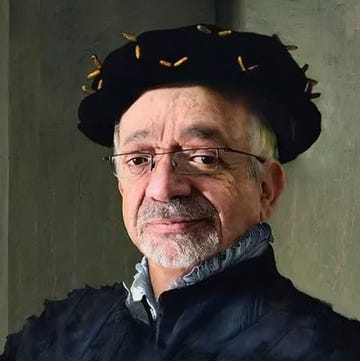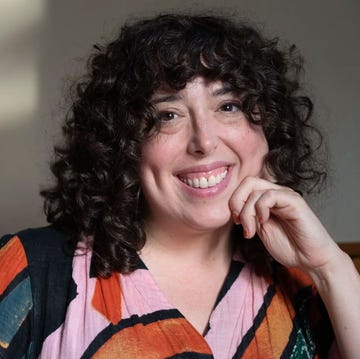When Daniel Mason began his fifth book, North Woods, an incandescent novel-in-stories or perhaps a profoundly inventive biography of a house, it was around the start of the COVID-19 pandemic, and he was living in New England. His earlier novel, The Winter Soldier, had taken years to complete, so he began this work with more modest ambitions. Raised in Palo Alto, he was struck by New England’s dramatic seasonal turns. Mason planned to set his new book in a single place, a fictional Massachusetts house surrounded by the natural world.
One fun part of this, he recalled recently, was research: adjusting his narrative to the historical changes that had occurred in the region over time. But equally important was “learning how to read the past natural state of affairs in the current landscape.… A lot of the research was walking around in these woods and coming across stones.… Depending on the kind of stone, you can tell whether the field was used for pasture or whether the field was used for agriculture. So you get a sense of maybe what it looked like 100 years ago.”
In his eyes, then, North Woods is about ecological succession.
The book begins with the story of a couple who flee Puritan villagers and place a stone foundation where they plan to settle once they’re certain they are safe. The house built on that foundation sees 400 years of changes—North Woods proves to be an invented cradle-to-grave biography of the house and its habitants.
As Mason writes, connections between characters, and across generations, begin to appear. Memorable occupants of the house include an energetic apple orchardist, his unhealthily enmeshed twin daughters, a medium who pretends she can pass along messages from the dead, and a closeted letter-writing painter. Both animals and supernatural elements take up the temporal interstices between human residents; a panther, we learn, stalks the house, and later, ghosts of those who once lived there emerge, as well. Even a spore carried on the breeze gets its own story.
Around the midpoint of the book, the medium, whose name is Anastasia Rossi, is called to the house because a current inhabitant believes she can hear a painter and his lover, whom Mason has introduced before, laughing and moaning, “delighted in each other’s presence.” Her husband is more skeptical. But Anastasia thinks that “even ghosts needed rules, and her clients came with different preconceptions of the spirit world. How many times had she been asked to explain what was essentially a metaphysics? Why was one house haunted while its neighbor wasn’t?... She loved making the stuff up, and the story that she had settled upon over the years was that which, frankly, enabled what seemed to be the best compromise of narrative possibility and constraint.”
In conversation, Mason acknowledged that Anastasia is the character in North Woods whose thinking is most like his own. At one point, she articulates the rules her ghosts will follow—which are also the author’s secret rules for the book. As he was writing, he encountered questions about the ghost from both his children and his editor. “What are the rules a ghost is going to follow?” he recalled them asking. “Can your ghost go through walls? Can your ghosts ride horses?” Through Anastasia, he arrived at a theory of invention: “creating something just familiar enough but not too familiar.… Telling them enough to keep the narrative moving along.”
Mason is an assistant professor of psychiatry at Stanford, but prior to this novel, he hadn’t written explicitly about this area of his work. Initially, he explained, the protagonist of The Winter Soldier was a psychiatrist, but Mason worried that readers might imagine the character was autobiographical and eventually gave him a different specialty. North Woods delves not only into psychiatric history, but also into the unusual states that sometimes accompany illness; mirroring their evolving linguistics, the book also sometimes features doctors’ developing understandings of various conditions.
One narrative features a mother desperate to help her son, Robert, who has been diagnosed with schizophrenia. Robert believes he is being harassed by a gang he calls the Harrow—a motif that also threads through subsequent stories. For him, the Harrow comes to seem an antagonist, as well as a symbolic stand-in for what’s destroying the natural world.
Although Mason has never had a patient who tried to record hallucinations on Super 8 film, as Robert does, he did use his knowledge of psychiatric history subtly, to develop this and other characters. The isolation of city life, for instance, makes Robert’s psychosis acute; when the character is immersed in green spaces, he does better. Once Robert is diagnosed, Mason acknowledged, “we’re thinking about it in diagnostic and medical terms,” but while that’s important for treatment, “in writing it tends to limit things.”
As he was working, Mason drew a secret floor plan of the house and also developed a secret timeline that never appears in the finished book. His strong enthusiasm for archival research led to his decision to shape the structure of the novel to emphasize the passage of time. Certain chapters, like the one about the panther, are narrated in verse (for which the author consulted the UC Santa Barbara English Broadside Ballad Archive), while others are epistolary. Layered throughout lie antique images that Mason also discovered in the archives. He enjoys the idea that the images, some of them quite strange, serve as connectors and provide a thread of continuity. They serve as “a curtain that, just like in a play, allows you to accept that a lot of years have now passed.”
Something similar emerges via Mason’s stunning command of language, which allows him to shift the style to reflect the English usage of the period in which various events occur. This means allowing himself to approximate the lavish landscape descriptions of the 19th century, or to create a letter by a woman taken captive that was inspired by existing captivity narratives. Over the course of the novel, he gradually evolves the language until it reaches present-day parlance. We’re not told the precise years in which events happen, but the flow of language reminds us that the unfolding of years happens smoothly and then surprisingly, much like aging.
Of his propensity for writing historical fiction, Mason had this to say: “I love how history…feels like it expands the palette I could use.… There’s something about another time and place that feels freeing in a way.” Unlike his other novels, however, North Woods possesses a magician-like sleight of hand that allows the tone to shift beautifully between emotional intensity and the puncturing of that intensity with humor and lightness. His earlier books, he admitted, were more earnest, “whereas now, with this…the mission was to explore and have fun or try different voices or see what happened or watch what happened.”
Curious about the settings of his books, I asked Mason whether he has any plans now to write a novel set in California. “It’s almost a joke with me and my family or my editor,” he answered, “about how the books really move geographically closer and closer to California—but they’re still not there yet.… It’s easier for me to say things I want to say if they’re set somewhere else.”•
Anita Felicelli is Alta Journal ’s books editor and the author of How We Know Our Time Travelers, Chimerica, and Love Songs for a Lost Continent.













